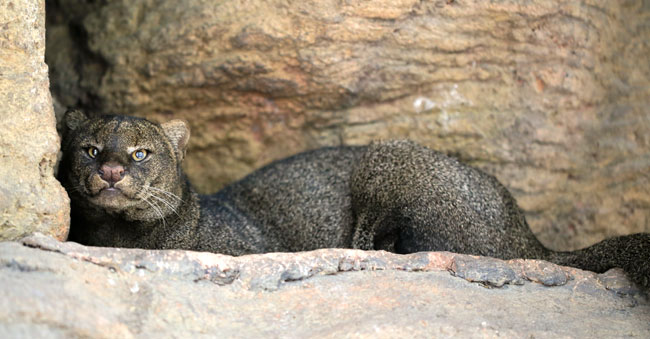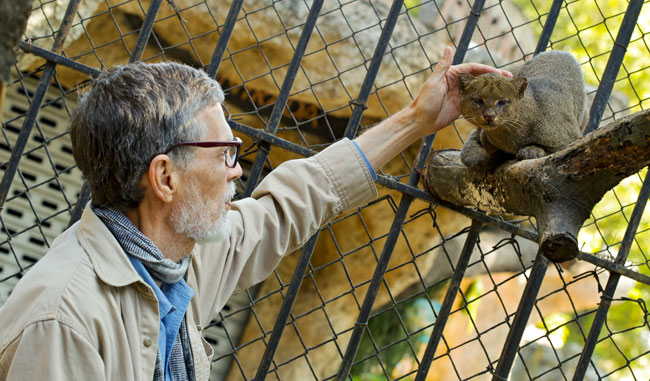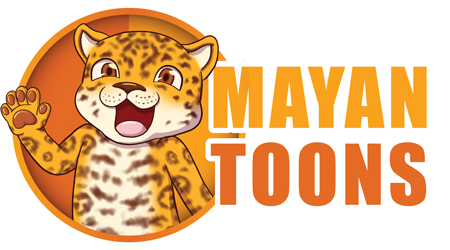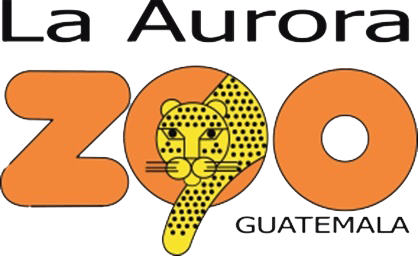Getting to know the personality of a jaguarundi, onza, in Guatemala
The first jaguarundi that I saw was in the ZooMAT, Tuxtla Gutierrez, Chiapas, Mexico. I went there several times while leading tour groups. Plus when I had free time and was nearby, I would ask for permission to come to the zoo, enter cages, and get to know the animals in-person. This was in the 1970’s through 1980’s.
During the 1990’s onward, I spent more time in the zoos of Guatemala. My impression of the jaguarundi was that, like a coyote or many other animals, it spent most of its day pacing the cage or enclosure. Always on the ground.
Thus it was a pleasant surprise to notice that at the Parque Zoológico La Aurora the jaguarundi was not pacing the floor. Two of the other jaguarundi felines were in a tiny rock cave (high up on a wall). The third feline was relaxing on a tree limb. All three were stationary; none were nervously pacing the floor.
The person who worked in this area of the zoo said that the jaguarundi on the tree limb accepted interaction with him, so gradually I moved closer, until I was literally face to face. I wanted to be face-to-face because it was precisely the face, and the head, of the jaguarundi that is fascinating: this is the size and shape of the face of a normal house cat, the kitty cat what grandmothers and kids love to have in their homes.
The zookeeper said that this one jaguarundi accepted occasionally being stroked on the back of the head and the shoulders (like a house cat). But I quickly learned the interacting with a jaguarundi is not like interacting with a house cat!
And the peccary that I learned to interact with at another zoo, the peccary was a real pig for pleasure. With the jaguarundi, the entire time I was rubbing it, it was 1000% focused on other people nearby. This feline cat made no indication whatsoever that it enjoyed being massaged (other than allowing me to do it).
And the peccary that I learned to interact with at another zoo, the peccary was a real pig for pleasure. With the jaguarundi, the entire time I was rubbing it, it was 1000% focused on other people nearby. This feline cat made no indication whatsoever that it enjoyed being massaged (other than allowing me to do it).
In distinction, the 350 pound tapir closed its eyes and angled its neck and shoulders so it could receive the maximum attention from my hand.
The collared peccary also closed its eyes, angled its body, and then to be absolutely sure that I fully understood its level of desire for more massaging, the peccary collapsed onto its side and rolled over to make it easy for me to rub at every angle.
So the peccary and peccary were just like dogs and house cats: they wanted attention and they wanted a good massage.
The jaguarundi definitely accepted attention, but clearly did not want to make this obvious. Plus, this Puma yagouaroundi was just like its giant relative the cougar: cougars have incredible vision, and can spot either danger or prey from impressive distances.
A jaguarundi is definitely not a lap dog for grandmothers (and it is increasingly recommended not to have wild animals as house pets), but there is no way I could get this close to a feline in the wild (other than shooting it with a needle to knock it out for a few hours). I prefer to interact with a functional jaguarundi (and a definitely fully functional 6-month old jaguar which we experienced last year).

The jaguarundi also wanted to play a bit
After the jaguarundi walked down the tree limbs and logs to reach the ground, it came over to me and started to play with the end of my scarf. When I pulled the scarf away, the jaguarundi reached for the end of my shirt-like jacket. I was a tad nervous that it would grab other (more tender) parts of my body, so I decided that we both had enough interaction for our first meeting. So I gradually stood up and moved slowly away. The jaguarundi went back to resting on his perch.
I hope someday to interact with another puma. And I would like to find a margay and ocelot which are keen on interacting with me. The ocelot allowed me to do close-up photography (less than 30 centimeters away). The ocelot’s only reaction to my presence was to keep closing its eyes and getting ready to go to sleep. In other words, this spotted feline had totally accepted my presence in its territory, enough that it felt safe and secure falling asleep directly in front of me.

Female Mayan comic book characters
Since women boxers are popular peaking last year (2015), it’s a potential time to offer female comic book characters with muscles. And this cat definitely has muscles. When I tried to give this jaguarundi cat the same kind of rub that I give to a kitty cat, dog, or even peccary or tapir, I noticed lots of muscles on the jaguarundi shoulders. Yet the face is perfectly normal for a kitty cat (even though this is a “shrunken but stretched “puma,” remember, its biological name is Puma yagouaroundi).
But we will also have normal Mayan females as comic book characters: not boxers, and not catty either. Since Maya is a common girls name in Eastern Europe and other countries, and since our entire ambience is the world of the Maya, it is appropriate to name our female hero Maya (the girl, not the wild jaguarundi cat comic character).
|
Our project is to document for the world the utilitarian plants and animals of the Mayan world, of southern Mexico, Guatemala, Belize, plus adjacent parts of Honduras and El Salvador. Instead of copying-and-pasting from plagiarized info from common web sites, we do research both in our own library and in peer-reviewed journals. Plus we then share our sources on our Mayan bibliography web site, www.maya-art-books.org. Rather than put our knowledge into “peer-reviewed journals” whose publishers gouge the public with greedy downloading fees, we prefer to have the world as our reviewers, so we issue our results in PDFs which are at no cost. To obtain our knowledge we learn from visiting the birds, reptiles, amphibians, mammals, insects and other creatures when possible, outside in nature preserves. But during 50 years in Guatemala, I have never seen a jaguarundi (or puma, ocelot or margay) in the wild (though I have seen two jaguars, one near Tikal; one near Calakmul, Campeche, Mexico). So to study jaguarundis we appreciate the access many decades ago at ZooMAT in Tuxtla Gutierrez, Chiapas, Mexico. But since that zoo is no longer easy to drive to (due to rise in problems at border crossings and then along the highways), we focus on zoos in Guatemala where the zoo directors recognize that we produce information for the general public (in addition for university students). Thus we tend to do our studies of animals especially at Parque Zoológico La Aurora and AutoSafari Chapin. www.aurorazoo.org.gt, Abierto martes a domingo, de 9:00 a.m. a 4:00 p.m. We thank the team at Parque Zoológico La Aurora for providing hospitality during the many years that we have done research photography here. |
Posted January 29, 2016.

